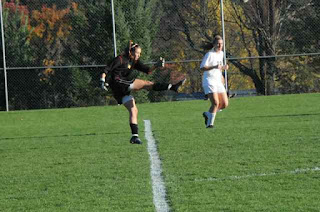On a Tuesday in June 1980 I ran from my desk at the Elizabethtown Chronicle to my 550 Suzuki motorcycle parked out back. I was running late for class on the second day of the summer trimester at Penn State's campus in Harrisburg, Pa. I could cover the 12-mile distance in 10 minutes, park close, run up the stairs and be on time.
It was mid morning and Route 230 was clear of traffic. I went over the hill and down into an S turn, which was followed by a flat stretch for three miles. In the middle of taking the S at 75 mph (speed limit 55mph) the handlebars started a rapid, back and forth wobble called a “tank slapper” by motorcyclists. I have long arms and had once overcome the wobble by snapping my arms straight.
My snap must have been off that day. The front wheel grabbed the pavement while turned all the way to the right. The bike launched into the air, back wheel first. The bike and I flipped and rolled across the center of the road and into the ditch nearly 100 yards away.
I felt no pain. It was a beautiful summer morning. At first, I thought I'd died and gone to heaven. Then I looked down. I was on my back and covered in dirt and blood. I'd crashed in front of a house that was being painted. One of the painters ran up and asked if I was okay. He covered me with a drop cloth and yelled for someone to call an ambulance. In the narrow clarity of shock, I told the painter I needed to get up and walk around or I would be stiff in the morning. He said, “You just stay where you are, son. Help is coming.”
After the flip, I hit face down on the road. The main impact points were knees and face. I suppose because of my boots, both knees hit on the left side and the road scraped away so much skin that I could see the ligaments. I did not see my helmet until after my two-week hospital stay, but the full-coverage helmet had grooves scraped in the chin bar and above the visor. After surgery on both knees and some very painful rehab, I was released from the hospital two weeks later and went back to class. I got good marks and sympathy, since I returned in a lot of bandages.
Readers might protest that I would not have died 100 years ago because I could not have gone that fast on two wheels. But bicycles and motorcycles have been the fast track to injury and death since they were invented. The physics are terrible—moving at high speed while perched on top of a vehicle that tends to flip when unbalanced. Bicycle racing was very popular at the turn of the 20th century. Racers were maimed and killed riding more than 40 mph on steeply banked board tracks. One of the more gruesome injuries came when a crashing rider was impaled by a long splinter. Indian started making motor-cycles in 1901; Harley-Davidson in 1903. By 1910 motorcycle racing was turning into a major attraction at state fairs. Helmets were as crude as the motorcycles. Injuries were terrible.
I'm alive to write about this accident because I had the good fortune not to hit anything solid on my high speed flips through the air. If I had hit an on-coming car or a tree or a curb at 75 mph my story would be over. Also, without the full-coverage helmet, landing face first would have killed me or made me wish I was dead. People who ride motorcycles without helmets or with those ludicrous “brain bucket” helmets should at least make sure they are signed up as organ donors before they ride.
The full-coverage helmet with all of the polymer technology inside and outside is the main reason I survived the crash. Rapid-response ambulance transport, effective treatment for shock and infection, and follow-up care kept me from the fate of riders who once rode without modern medicine.
http://www.chemheritage.org/community/periodic-tabloid/2010-12-03-how-i-would-died-motorcycle.aspx?










































